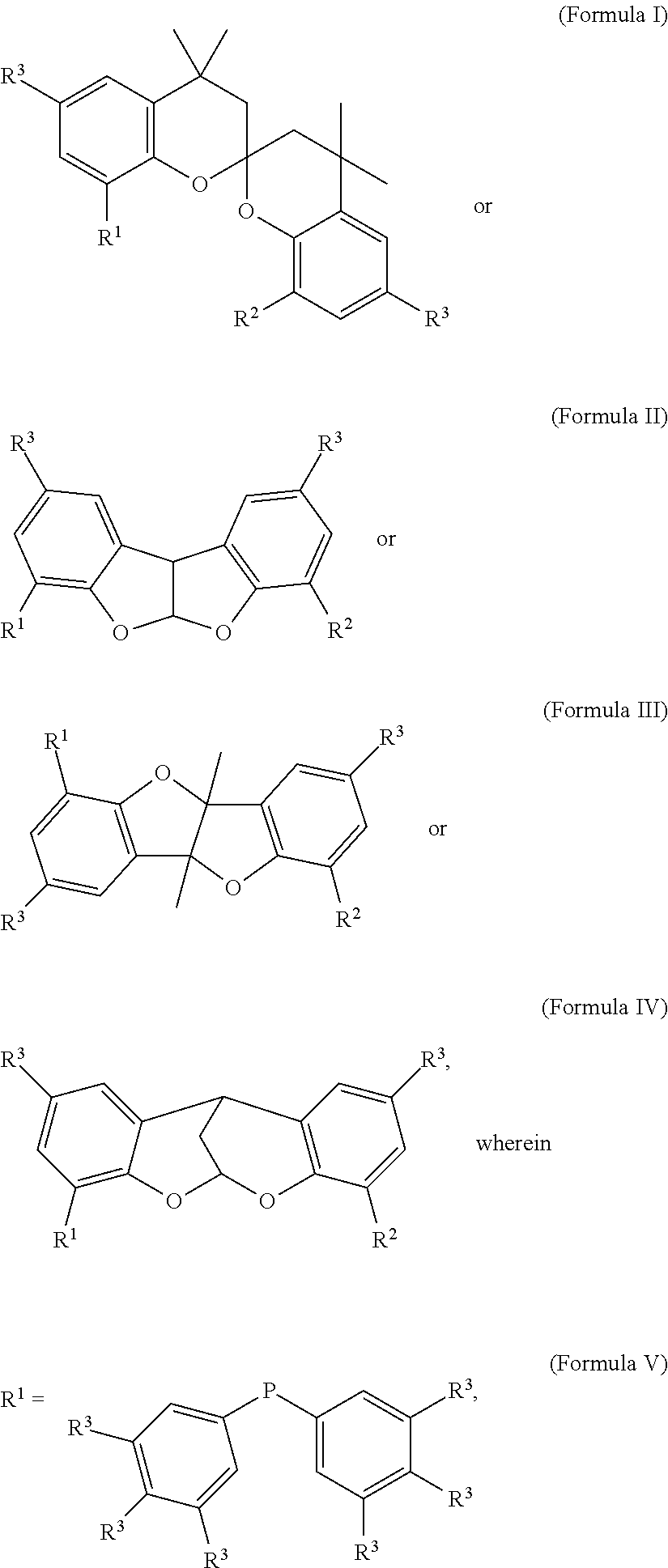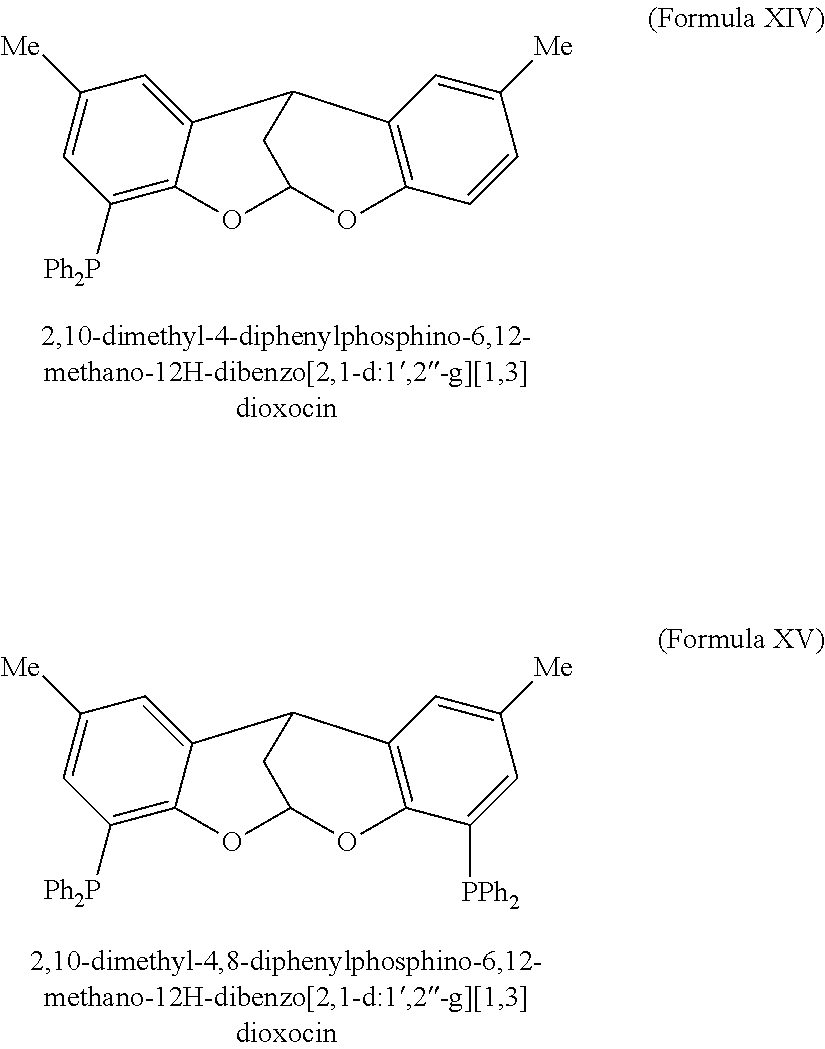Phosphine-based catalysts useful for the telomerization of butadiene
a phosphine-based catalyst and butadiene technology, applied in the field of new phosphine-based ligands, can solve the problems of not meeting the desired yield of 1-octene, and none of the known methods appears to satisfactorily achieve the goal of increasing the catalytic activity and yield
- Summary
- Abstract
- Description
- Claims
- Application Information
AI Technical Summary
Benefits of technology
Problems solved by technology
Method used
Image
Examples
example 1
(a) Synthesis of 4-bromo-4,4,4′,4′,6,6′-hexamethylspiro-2,2′-bichroman
[0028]An amount of a starting material (“backbone”) 4,4,4′,4′,6,6′-hexamethylspiro-2,2′-bichroman (2 grams (g), 5.9 micromoles (mmol)) and N-bromosuccinimide (NBS) (1.05 g, 5.9 mmol) are dissolved in dimethylformamide (DMF) (100 milliliters (mL)) and stirred at room temperature for one day. The conversion of the starting 4,4,4′,4′,6,6′-hexamethylspiro-2,2′-bichroman is monitored by gas chromatography / mass spectroscopy (GC / MS). The solvent is evaporated to dryness and the solid is washed with water and extracted with ether. The ether is dried over magnesium sulfate (MgSO4) and evaporated to dryness. The obtained solid is washed with ethanol to give 2 g of a white solid that contains a mixture of monobrominated, dibrominated, and unconverted 4,4,4′,4′,6,6′-hexamethylspiro-2,2′-bichroman in a 65 / 15 / 20 ratio. This product mixture is used in step (b) without further purification.
(b) Synthesis of (4,4,4′,4′,6,6′-hexamet...
example 2
(a) Synthesis of 4-bromo-2,8-dimethyl-5a,10b-dihydrobenzofuro[2,3-b]benzofuran
[0030]The backbone 2,8-dimethyl-5a,10b-dihydrobenzofuro-[2,3-b]benzofuran (1.5 g, 6.3 mmol) and NBS (2.016 g, 11.3 mmol) are dissolved in DMF (100 mL) and stirred at RT for 1 day (flask is covered with aluminium foil). The conversion is monitored by GC / MS. After three days, a mixture of the monobrominated product, the dibrominated product, and the unmodified backbone (monobromo / dibromo / backbone) is formed, in a 75 / 23 / 2 ratio, based on weight percents. The solvent is evaporated to dryness and the solid is washed with water and extracted with dichloromethane. The dichloromethane solution is then dried over MgSO4 and evaporated to dryness. The solid obtained is washed with ethanol to give a white solid (1.5 g, containing a mixture of monobromo / dibromo, 75 / 25). This product (“bromobackbone”) is used in step (b) without further purification.
(b) Synthesis of 4-diphenylphosphine-2,8-dimethyl-5a,10b-dihydrobenzofu...
example 3
(a) Synthesis of 4-bromo-2,8-dimethyl-5,10-methano-10H-dibenzo[2,1-d:1′,2′-g][1,3]-dioxocin
[0032]The backbone 2,8-dimethyl-5,10-methano-10H-dibenzo[2,1-d:1′,2′-g][1,3]dioxocin (1.5 g, 5.95 mmol) and NBS (1.477 g, 8.29 mmol) are dissolved in DMF (100 mL) and stirred at RT for 1 day. The conversion is monitored by GC / MS. After three days, a mixture of the monobromo / dibromo / backbone is formed, in a 76 / 9 / 13 ratio. The solvent is evaporated to dryness and the solid is washed with water and extracted with dichloromethane. The dichloromethane solution is dried over MgSO4 and evaporated to dryness. The solid obtained is washed with ethanol to give a white solid (1.5 g, containing a mixture of monobromo / dibromo 90 / 10), which is the bromobackbone. The solid bromobackbone is used in step (b) below without further purification.
(b) Synthesis of 4-diphenylphosphino-2,8-dimethyl-5,10-methano-10H-dibenzo[2,1-d:-1′,2′-g][1,3]dioxocin (Formula XIV)
[0033]A solution of the unpurified bromobackbone from...
PUM
| Property | Measurement | Unit |
|---|---|---|
| temperature | aaaaa | aaaaa |
| temperature | aaaaa | aaaaa |
| temperature | aaaaa | aaaaa |
Abstract
Description
Claims
Application Information
 Login to View More
Login to View More - R&D
- Intellectual Property
- Life Sciences
- Materials
- Tech Scout
- Unparalleled Data Quality
- Higher Quality Content
- 60% Fewer Hallucinations
Browse by: Latest US Patents, China's latest patents, Technical Efficacy Thesaurus, Application Domain, Technology Topic, Popular Technical Reports.
© 2025 PatSnap. All rights reserved.Legal|Privacy policy|Modern Slavery Act Transparency Statement|Sitemap|About US| Contact US: help@patsnap.com



